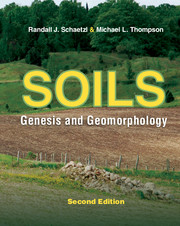7 - Basic Concepts: Soil Organisms
Published online by Cambridge University Press: 12 January 2024
Summary
Life is not only an integral part of the soil; it is the essential part – the part that distinguishes Earth's soil from biotically sterile and comparatively and stunningly simple soils of other planets. Organisms literally make the soil what it is (Verboom and Pate 2013). Ecologists have traditionally portrayed soil organisms as wholly contained within a black box labeled decomposers, i.e., a single trophic level through which all aboveground material, with its multiple trophic levels, is ultimately recycled (Sugden et al. 2004). Current research, however, has repeatedly shown that the soil food web is just as complex as its aboveground counterpart, or even more so.
Soils teem with life of all kinds, and soil organisms can be classified according to a variety of different criteria. Functional classification schemes group organisms according to their role in the food web (Table 7.1; Fig. 7.1), whereas phylogenetic classifications (the basis for the binomial system of scientific names) are based upon organisms’ morphology, physiology, habitat, and genetic relationships. With respect to soils, organisms (particularly soil fauna) can be classified on the basis of where they spend most of their life cycle, e.g., wholly within the soil, partially within the soil, above the soil, and which parts of their life cycle are spent in each domain (Fig. 7.2). Hole (1981) also classified soil biota on the basis of how often and where they inhabited the soil, using slightly different criteria (Table 7.2).
Living things were originally divided between the plant and animal kingdoms, but organisms are now classified into three major domains: eucaryota, bacteria, and archaea (Woese et al. 1990). Eukaryotes – the higher order and hence, more complex, organisms – have their genetic material organized inside a nuclear membrane. They can be single-celled (algae, yeasts, most protozoa) or multicellular (most fungi and all the various plants and animals). Eukaryotes range from primary producers at the bottom of the food web to predatory animals at the top. In contrast, the cells of prokaryotes (Bacteria and Archaea) lack a nuclear membrane and an organized nucleus. Clearly important in swamps and in the initial colonization of extreme environments, Archaea also play a role in the nitrogen cycle. Details of the role of Archaea in soil genesis are poorly understood at present but fast developing (Leininger et al. 2006, Hatzenpichler 2012, Zhalnina et al. 2012).
- Type
- Chapter
- Information
- SoilsGenesis and Geomorphology, pp. 95 - 108Publisher: Cambridge University PressPrint publication year: 2015

